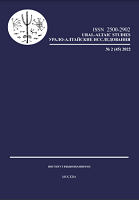Изменение этноязыковой территории западных и южных манси в XVII—XX вв. Часть I. Предуралье и бассейн Туры
Changes in the ethno-linguistic territory of the Western and Southern Mansi in the 17th—20th centuries. Part I. Cis-Urals and the Tura basin
Author(s): Yuri B. KoryakovSubject(s): Historical Linguistics, Sociolinguistics, Cultural Anthropology / Ethnology
Published by: Институт языкознания Российской академии наук
Keywords: Mansi language; Voguls; linguistic geography;
Summary/Abstract: This article examines the changes in the ethno-linguistic territory of the Mansi (Voguls) in the Cis-Urals and in the Tura basin during the 17th—20th centuries. In most of these lands, the Mansi and Mansi languages disappeared no later than the early / middle 19th century. But the assimilation and displacement of the Mansi took place a little differently and at different speeds in different parts. The purpose of this article is to bring together and systematize information about the distribution of the Mansi and Mansi languages in the western and southern parts of their range during the 17th—20th centuries. Both primary sources of the 17th—19th centuries and the works of researchers of the 19th—21st centuries were used as material for the study. Particular attention is paid to census data, as well as data on yasak payers of the 17th century. The result of the work is a detailed reconstruction of the geographical distribution and demographics of the Mansi in this region after the 17th century. All toponyms mentioned in earlier works were georeferenced, and diachronic correlation of objects from different time layers was made. For convenience of presentation, the territory under consideration is divided into several sub-areas. Special attention was paid to the time of the disappearance of the Mansi languages in each sub-area and more accurate georeferencing of the known Mansi dictionaries of the 18th—19th centuries. The collected and systematized information is illustrated by detailed ethno-linguistic maps, which make it possible to compare the situation with the Mansi and the Mansi language in different centuries. Such an analysis, based on the areal principle and accompanied by detailed maps, is being done for the first time. The results of the work, including maps, can be used by specialists of various profiles, incl. linguists studying Mansi dialectology and toponymy, ethnographers and historians.
Journal: Урало-алтайские исследования
- Issue Year: 2022
- Issue No: 02 (45)
- Page Range: 58-78
- Page Count: 21
- Language: Russian

